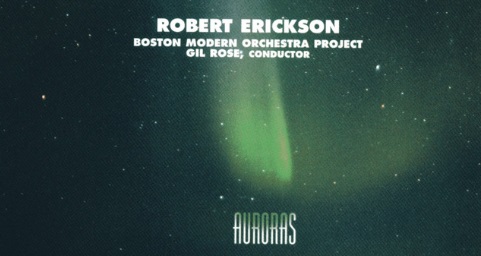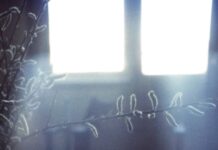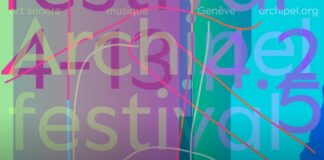I lavori orchestrali di Robert Erickson sono importanti per il modo con cui incarnano molti dei principi della composizione timbrica elaborati nel suo libro “Sound Structure in Music”. I quattro pezzi orchestrali raccolti sul cd “Auroras” coprono il periodo 1954-1982/85, e tracciano una visione in continua evoluzione su come riequilibrare la relazione tra altezze dei suoni e timbro. In modi differenti, tutti e quattro i lavori offrono soluzioni al problema che Erickson descrive come la lineare organizzazione del timbro in rapporto alle altezze. Questo cd, come il cd di Erickson “Complete string quartets”, mostra una mente dinamica che esplora le possibilità che nascono quando il timbro viene trattato come un parametro musicale a sè stante.
Robert Erickson’s music has seen something of a revival recently. Within the past few years there have been releases of his complete string quartets as well as a collection of his compositions for orchestra. While the later string quartets embody certain qualities and handling of material characteristic of his mature style—his use of drones and pentatonic melodic material, for example—the orchestral work is important for the way it puts into practice many of the principles of timbral composition elaborated in his 1975 book Sound Structure in Music.*
In his book, Erickson shows how, to the extent that the composer focuses attention on timbre rather than conventional melodies or harmonies, the orchestra can serve as a medium for painting with sound. This may be a matter simply of the judicious parceling out of pitches and melodic segments among instrumental voices, or it may be a matter of minimizing pitch material in favor of timbral movement. Erickson’s engagement of the relationship between pitch and timbre has been a dynamic one, and thus it isn’t surprising that the four orchestral works brought together in the CD Auroras(New World Records 80682-2), spanning the period 1954-1982/85, trace an evolving outlook on how to rebalance these two sound parameters.
Fantasy for Cello and Orchestra, the earliest work represented on the CD, carries traces of the melodic and contrapuntal conventions of twelve-tone composition, which Erickson studied under Ernst Krenek in the 1930s-1940s. The Fantasy was composed in 1954, the year before Erickson’s book on melody and counterpoint, The Structure of Music, was published. Like the book, the Fantasy would seem to represent the culmination of Erickson’s interest in predominantly contrapuntal music. A highly expressive work, it features a melody formed around a chromatic pitch set that is stated by the cello and taken up in fragments by the string section. Even here, where the line is the predominant quality, timbral elements play a central role in defining the profile of the piece as well as in revealing the line. For example, Erickson brings winds in to shade the strings, uses flute and oboe to offset the solo cello (ably played by Rose Popper-Keizer), and deploys brass to sharpen the edges of the more dramatic passages. Overall, he has color maintain the melodic clarity of the lead line, whether having the cello enunciate it solo or dividing pieces of it among the brass and string sections.
Night Music of 1978 breaks with the dynamic expressionism of the Fantasy, centering itself instead on F and C drones rather than pitch sets. In contrast to the Fantasy’s melodically-driven organization, both movement and thematic continuity come by way of pitched percussion and pizzicato double bass, the former used to reinforce the percussive attack of the latter. Much of the work involves an exploration of wind and brass timbres through trills and embellishments on bass clarinet, flute and clarinet, and through the amplified trumpet’s microtonally fluctuating deviations from the drone. The collective effect is of a bright-edged sound mass or of a one-note klangfarbenmelodie passed around among low brass and strings and the higher-register winds.
Composed two years after Night Music, East of the Beach highlights the timbral variety of a small orchestra using limited pitch material arranged in a sort of mosaic. A three-part, one movement work, East of the Beach begins with a single E sustained by brass, strings and winds, with coloristic percussion in the background. The unison and octave doublings sometimes bring out different overtones and sometimes bring out a sonorous shimmer from colliding microtonal slippages. The second section moves to a contrapuntal melody mostly given to the strings, an implied or explicit E pedal helping to give the section the feeling of a mode centered on C. The brisk final section breaks up a rapidly pulsing line into fragments to be distributed like so many multicolored tiles among arco and pizzicato strings, winds and brass.
Auroras (1982, revised 1985), for a larger orchestra, is an essay on the spatialization of sound. Erickson accomplishes this in part by maintaining a discrete separation of brass, winds and strings throughout much of the work. The resulting effects on textural detail contribute much to the sense of dynamic proximity and distance of individual instruments or instrumental choirs. The pure colors of horns and strings, both solo and in ensemble, are especially prominent; quiet, relatively sparse passages for flutes provide an effective contrast to the weightier sounds of brass and multiple strings. The work was inspired by the sounds of birds at daybreak, and without being transparently programmatic, Auroras does succeed in creating with the orchestra a musical analogy to the localized, intermittent sounds of birdsong.
As different as these four compositions are, all would seem to represent solutions to what Erickson in Sound Structure in Music termed the problem of the linear organization of timbre in relation to pitch. In both the Fantasy and Auroras this solution tends to take the form of articulating melody or thematic material through the contrast of timbres identifiable as belonging to specific instruments or instrumental choirs. In the two middle works, on the other hand, significant passages hold pitch constant or nearly constant while timbre undergoes variation. Here, the progression of the line is organized around sound rather than melodic or harmonic movement. With changes in pitch moved to the background, changes in timbre become the focus of attention, and the melody unfolds as a sequence of timbral objects defined by instrumentation.
This set of orchestral pieces, finely realized by the Boston Modern OrchestraProject, makes a good companion to the collected string quartets. Both compilations show a dynamic mind exploring the intricate possibilities that arise when timbre is treated as a musical parameter in and of its own right.
*Discussed recently on Percorsi Musicali.







